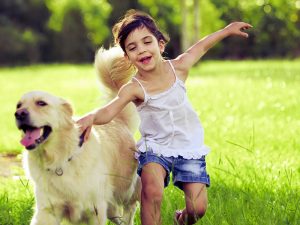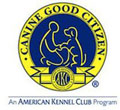The relationship between kids and dogs isn’t always as easy as it seems!
Written by Ericka Kinsey, M.Ed., CPDT-KA, Family Paws Parent Educator
Your child and your dog: Lassie Goals

Most of us have visions of our children happily romping in the backyard with a loving dog, one who follows them around and spends the night curled up in their bed. Many children love to hug, kiss, and cuddle with dogs. Some parents get a puppy with the intention that the puppy and their child can grow up together. So why doesn’t this idyllic scene always play out?
A failure to communicate
Humans and dogs are two very different species, sometimes the differences in communication and social interactions are significant enough to cause discomfort, fear, or even anger in a dog when someone breaches their comfort level – especially when that little human doesn’t “listen” to the dog’s signals to back off. For example, when humans greet loved ones, they hug and kiss – and children naturally want to do this to their furry friend, too. Unfortunately, to many dogs, a hug feels like restraint rather than love. Attempts to pull away are sometimes met with a tighter hug – leaving the dog feeling that the only way to escape is to make the human back off by growling or biting. Let’s be clear here: aggression is not a personality trait, it’s a tool that animals use to solve a problem. No one is to blame here – the child and dog were both only doing what they know.
Is it play, or is it something scarier?
Toddlers are always on the move – and they’re not always very coordinated. Remember how often your toddler fell when first learning to walk? Your dog does, especially if the toddler fell near (or worse, on) your dog. Older children love to yell and jump and run. While some dogs might become nervous, others will get excited and want to join in, and unfortunately, dogs play with their mouths. Once again, no one is at fault – the dog and the child are both only doing what they know – but rough play often leads to a tearful child and a dog in time-out.
How do we ensure our children and dogs interact safely while developing a healthy relationship?
- Learn to read canine body language so you know when and how to modify the environment to keep your dog comfortable and your child safe.
- Children mimic adults, so model appropriate behavior toward dogs so they learn safe interactions. If you wouldn’t want your child to do it to your dog, you shouldn’t do it either. NEVER allow your child to sit on your dog.
- Attend our quarterly Kids and Dogs workshop with your child, where you will learn how to understand your dog’s communication along with games they can play together.
- Use baby gates, exercise pens, or crates to separate dogs and young children when an adult can’t actively supervise.
Additional Resources
- Check out the free resources on the Family Paws Parent Education website, including the interactive body language game.
- Watch the video (no children, please) at Stop the 77.
- Contact us if you have questions, would like support with a child and dog relationship, or if you are expecting and want strategies to help transition from “dog parents” to “parents with a dog!









